- Norms and requirements of SNiP
- Relations with neighbors
- Basic Distances
- Types of fences
When you acquire a new allotment of land for use, a dacha outside the city or within its boundaries, it is quite natural that you want to enclose your legally obtained land with some kind of fence. Each person has their own reasons for doing this. Here are some of them:
How far should the sprinkler line be from wooden fence? There are several questions that come to mind here. Much of this applies to walls as well as fences. Both of these machines tend to slide from side to side or get out of position when operated, especially by the inexperienced non-professional. You don't want the car to go over the fence. Future maintenance: One question here is future maintenance if you need to dig a pipe for repairs. You need enough space so that you don't hit the shovel handle against the fence if you have to dig.
- one wants to show all his neighbors his wealth and builds a fence that looks like the walls of an old castle, decorating it with turrets and flags;
- the other wants to separate himself from all the neighbors, whom he considers curious and importunate, and builds a blank high wall;
- the third, on the contrary, to show his openness, builds a low (1-1.5 m) fence, and everyone passing by can freely “spy” on his life.
When building a summer house, it is necessary to accurately plan all the dimensions of not only the house itself, but also the distance between the house and the fence. In this case, all building codes must be observed.
That would mean at least a foot away from the fence. Maintaining the fence is another problem. If you spray water on the fence, it will shorten the life of the fence, not to mention leaving ugly water stains on it. It is almost impossible to remove water stains from a fence.
Sprinkler heads and water stains on the fence. Sprinkler heads should probably be about a foot away from the guardrail. The closer they are, the more water they will hit the fence. The water will stain the fence and also shorten the life of the fence. To keep the water completely outside the fence, the sprinklers must be very far from the fence, typically at least 24 for spray, 36 for large radius rotors. There are variables that affect the distance they need to get away from the fence.
Norms and requirements of SNiP
Many people install a fence or fence on their own, despite the documents indicating how and what is allowed to be installed. Therefore, when building a country or country house, it is best to contact specialists who know all building codes and regulations. As you know, all SNiP provide comfortable living in a particular room.
Different sprinklers have different accuracy in relation to the edge of the water pattern. Impact type rotors often spray large amounts of water to the side, outside of normal watering, so they must be very far away. Also, the wind plays a huge role in blowing water on the fence. Do not plant a lawn next to a fence!
In general, it's considered bad landscaping to put a lawn next to a fence unless it's a very attractive fence that you want to be the focal point of the landscape! Standard practice is to "buffer" the appearance of the fence with a shrub plantation along the base of the fence.
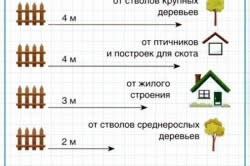
There are various standards and requirements for the required area of small rooms located in the attic of the building, for bedrooms, corridors, for the width of stairs, ceiling height, and so on. For example, a bedroom should not be less than 7 sq.m, corridors - 9 m, stairs width - 90 cm, ceiling height - at least 230 cm, etc.
When is a fence permit required and what is the fee?
According to the City Ordinance found in all fences between 4 and 6 feet, a fence permit is required. If the fence is larger than 6 feet, the applicant must submit a waiver of the fence ban to the Urban Design Committee for review. If the Committee approves the application, the applicant will then apply for a building permit. This includes labor and material.
How close can a fence or driveway be to a property line?
A fence can be placed on the property line.
Is a permit required for a barn
Yes, the barn requires a permit. Under the Massachusetts state building code, any barn over 200 square feet will require a building permit, building plans, and a survey showing the placement of the barn on the site.Everyone knows that SNiP describes all possible cases for simple design and planning of the location of buildings, both non-residential and residential. For example, the distances at which separate objects or complexes of buildings should be located from each other during the development of private plots are indicated; planning rules for land areas (both private and public).
When should smoke alarms be updated?
Zoning Compliance: Side and rear setbacks for all accessories must be 5 feet. If one or more smoke or heat detectors are required, all required detectors must be installed in such a way that the activation of any detector will cause an audible alarm in all the required smoke detectors in that unit.
What are the requirements for bedroom windows?
Activating a detector in a residential area should not activate alarms in any other residential area or common areas. R-310; One and two family residential complex. Sleepers must have at least an operational emergency window or external door approved for emergency exit or rescue in each of these spaces. These window units must work from the inside to a full clear opening without the use of a key or special tool and open into a courtyard leading to a public path.
For independent planning (the first step to the correct location of objects), they draw up a plan or diagram (map) on a large sheet of drawing paper (drawing paper).
Measure all the distances on the ground and transfer to your drawing at the required scale, including the buildings of the neighbors.
Back to index
Emergency window windows must have a sill height of no more than 44 inches from finished floor to opening. Exceptions: Floor openings must have a minimum opening of 5 square feet. Double fork windows must have a minimum net opening of 3 square feet.
Distance to outbuildings
A detached garage can be no more than 3 cars and 700 square feet, and the height of 22 feet is measured from the middle level to the highest point sloping roof. The attached garage can be a maximum of 3 cars and 700 square feet, and the height of 30 feet is measured from mid-level to the highest point of the sloping roof. The offset must meet the building recovery requirements set in seconds. 30. Side and back setbacks should be 5 feet. . The New York City Building Code sets out the requirements for installing backyard fences and gardens.
Relations with neighbors
The lion's share of such conflicts just falls on the wrong (according to one of the parties) placement or type of fencing. Often these domestic conflicts are the basis of criminal proceedings. Here are some of the reasons for such conflicts:
- the fence goes far to the side of the neighbors;
- the fence is too deaf or high;
- during the construction, the norms were not taken into account, that is, the fence obscures the plot of the neighbors;
- many other (sometimes far-fetched) reasons.
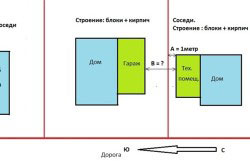
In limited cases, work plans and permits are required. The Department of Buildings does not require property owners to hire an architect or engineer, provide design plans, or obtain a work permit to install fencing. Homeowners can install their own fencing, but if you hire someone to do it, make sure it's a "home improvement contractor" licensed by the Department of Consumer Affairs.
Distance between buildings on the site
Residential and commercial privacy fences are usually made of wood, plastic, brick, or chain link. Protect yourself before installing the fence. Get a licensed surveyor to make sure the fencing will be within your property line.
One of the common mistakes of developers is the unsteady distance from the house to the fence, which is described in the SNiP and most often not taken into account by both the owners of the summer cottage and the builders. Therefore, before starting to build a new country house, it is better to take a tape measure and measure all the distances, calculate, and only after that do the marking of the future foundation for the house. All this is necessary so that in the future, when country house will be built, it was easy and convenient to walk from the gate to the porch.
Canopy storage is only allowed in the back yards. Prefabricated and custom barns are similarly regulated under New York law. Homeowners may not need to submit work plans to the Department of Buildings or defend work permits to install a backyard shed—unless it is three feet from the property line. If this is the case, work plans should state that the barn is constructed from non-combustible materials and meets dimensional requirements.
Relations with neighbors
Materials: Sheds made of flammable materials must be at least 3 feet from the property line.
- Size: up to 120 square feet - no permits required.
- Above 121 square feet - plans, approvals and permits.
- Height: 7'6" maximum.
- Installation: Sheds cannot be permanently attached to the ground.
Tools and materials:
- compasses (if you can get it somewhere);
- measuring bar (any bar of known length, usually 2 meters);
- tape measure 3-5 meters (the more the better);
- drawing paper;
- drawing tools;
- metal pins (pieces of reinforcement), wooden pegs and flags (for marking).
Many people move the boundaries of the house to the fence (to increase their yard and sowing area), which is strictly prohibited. You need to know that the distance is not measured from the fence itself (since the fence can be wide), but from the boundary to the basement of your house. Moreover, if the house has elements protruding beyond the base (roof, canopy, porch), then measure the distance from the boundary to the projections of these elements on the ground.
This is because the electric fences are connected to a small device, a small center that receives all the information sent by the fences, and that if electricity is sent through the wires, this energy is transmitted in bands of shorter duration, usually in milliseconds, immediately creating about 1 second of inactivity. until a new electrical impulse is sent. This pause is extremely important, because in the case of continuous electricity it may happen that a person cannot create distance from the fence wires.
Back to index
Basic Distances
SNiP also help determine the distance to the neighboring plot, which should be at least 3 m. But due to the fact that the plots are quite small and standard, in practice it is sometimes impossible to comply with this condition, since then the buildings are close enough to the fence and there are no there is free space. If there is no fence in the country house, then it is not so noticeable, but in most cases between summer cottages fences are put up. It is always necessary to take into account the fire distance between all neighboring houses.
With a pause, what happens is that a person has the opportunity to move his leg, arm, to avoid an accident. The electrical discharges that are directed through the fence usually have a high voltage but a low current. Connecting to the alarm center The effectiveness of the electric fence can be combined with the ability to respond quickly and quickly if it is connected to the alarm center, so you can receive an alarm notification whenever the electric shutter is triggered to prevent an intrusion attempt.
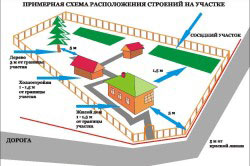
Based on the foregoing, it can be seen that if the neighbor on the side completed the construction of the building earlier, then you need to retreat to a normalized distance and then. So, for example, from a stone building to a fence there should be at least 6 m. If the house is built of wood and stone, then the building is 10 meters from the fence, and if the buildings are wooden, then 15 m must be left between the fence and the house.
What to do if the neighbors do not want to sign the act
Stainless steel. Stainless steel is the material that forms the electrical fence and runs through the stainless steel wires that circulate the electricity that is sent into pulses. Electric battery The electric fence system must operate 24 hours a day, 7 days a week, this equipment is always installed with an electric battery.
Recent electrical installation equipment. Like all equipment and technology, this device has changed a lot, and today one of its advantages is the ability to integrate into a home security system. One way to increase the effectiveness of electric fencing is to add concertinas.
The most important stage of individual construction country house the fencing of the site and the erection of a fence are considered. The main thing is not only to choose the material for it, but also to place it correctly on the border of your site. After the boundaries are marked with boundary marks, they proceed to the installation of the fence itself, which will not only protect the territory, but also fix the real boundaries between all neighboring summer cottages.
Neighbor rights. In the case of installing an electric fence on a wall or a wall that is shared by residents, partitions, in which case the installation of an electric fence system requires authorization or must be installed at a 45 degree slope to the inside of the property you are protecting, this will minimize the damage that can be caused by the fence to third parties.
We highlight the fact that the minimum wall height is 2.20 meters, does not allow an electric fence to be connected directly to the power supply of the house, does not allow vegetation to touch the fence, or that it works when caring for trees by pruning minimum distance to the storage place of liquefied petroleum gas is 3 meters.
As everyone knows, SNiP are the rules that the developer must comply with so that in the future he does not have trouble with local authorities regarding illegal construction. In order to build various buildings, you will need permission from the local administration. If the boundaries of your site have not yet been included in the cadastral plan, then you should not install a permanent fence. The start time of work must be agreed with the neighbors, and you will have to finance all these works, since this issue is not regulated by law and these works are mainly paid by the initiator, although you can agree with the neighbors and share the costs.
The company or technician who installs the electric fence must be professionally qualified for the purpose. The electric fence should have a maximum voltage of 000V, the duration of the electric pulse should be 10 milliseconds, the maximum current can reach 5mA, the interval between electrical impulses should be 1.2 seconds. Electric fence warning signal There is an obligation to display an alarm that allows you to receive information about the presence of an electric fence, including symbols that may be perceived by people who are illiterate.
When constructing a summer cottage, a temporary fence can be placed between the land plots from a special mesh Rabitsa. The main thing is that it should not be made of a solid canvas and that it can be quickly dismantled if necessary. The PPZ document (land use and development rules) establishes the norms and requirements for fencing the site, in fact, it contains the basic norms that govern all issues related to construction on the territory of any municipal representative office.
When starting to design and then build their house, not many people think about what distance between buildings is safe, at what safe distance from the building the fence should be located. This way of doing things is not entirely correct. More precisely, it is completely untrue. There are a number of documents that regulate these issues. And before any construction, they must be studied so that in the future you do not have to deal with demolition, payment of fines and other unpleasant and costly things for you.
Distance from the fence to the house
In our case, we call the fence the border that separates yours from the neighbor's. To be fully informed, you need to study the following documents:
- land and urban planning codes of the Russian Federation
- fire safety requirements set out in the Federal Law No. 123 of 07/22/08
- (updated version of SNiP 2.07.01-89, effective since 2011)
- (updated version of SNiP 30-02-97, valid since 2011)
- SanPIN 42-128-4690-88
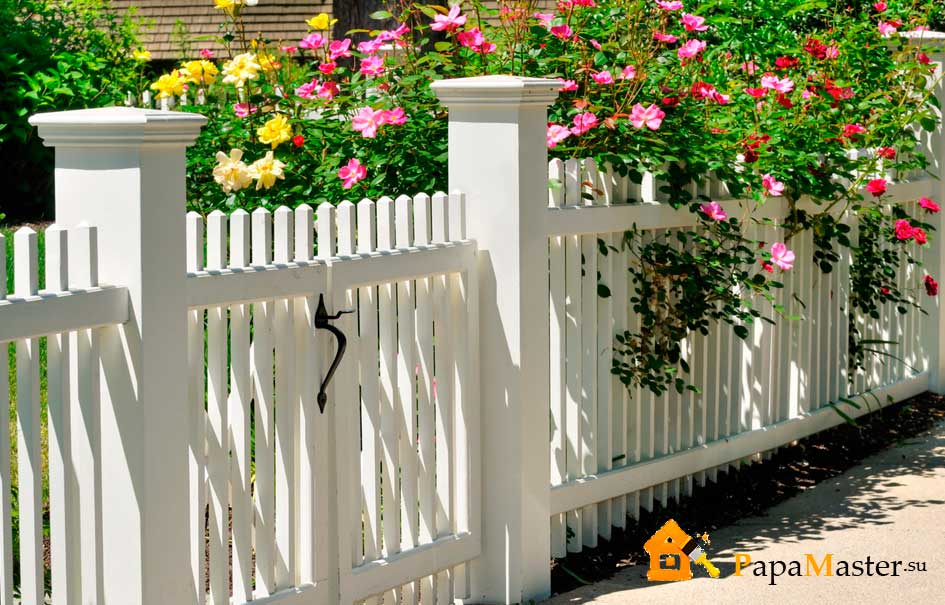 distance from the fence to the house
distance from the fence to the house 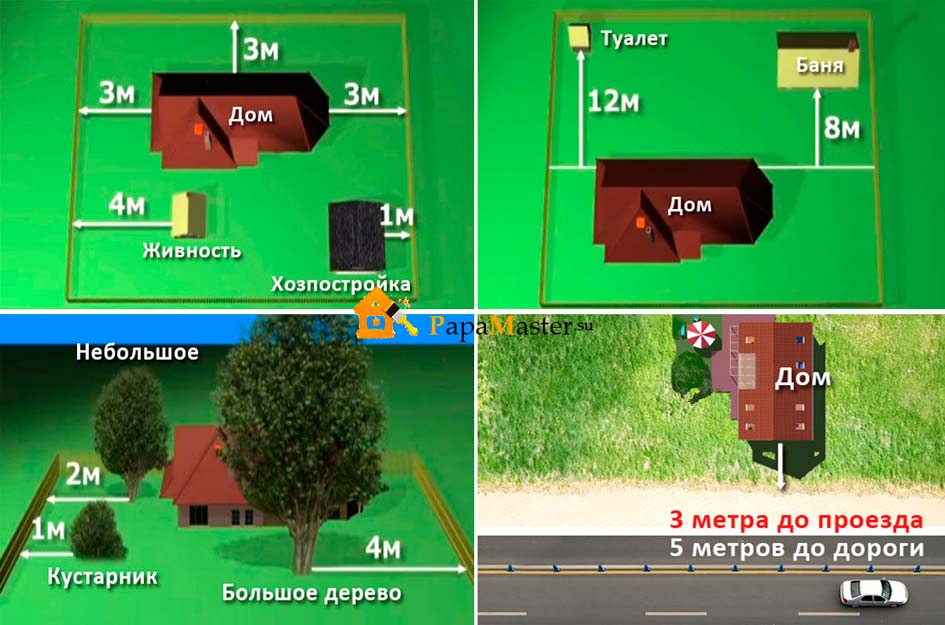 scheme of distances from the fence to the house and other buildings
scheme of distances from the fence to the house and other buildings
So that you do not have to study them in their entirety, we will provide you with the main positions that will help to present the overall existing picture. All of the above documents regulate the rules for building on the site. So, back to the question of the distance from the fence to the house. To avoid a showdown between you and your neighbors, you just need to follow the rules of not only building the site, but also its landscaping. First moment:
- The house must be located at a distance of at least three meters from the neighboring estate. This applies specifically to residential buildings. However, as a rule, there are other buildings on the site, such as sheds, a bathhouse, and others. For each of them, there are also location rules.
- Any pets that reside on your property must be kept at least 4 meters away from the border
- Sheds, garages, workshops and other objects of this type - are built no closer than 1 m from the neighboring estate
- Special attention should be paid to such buildings as a bathhouse and a toilet. In this case, they can be built anywhere and at any distance from the border. In other words, you can have them at least close. However, there is a certain nuance here. The condition of the location of these buildings in relation to residential building. We put the bathhouse 8 meters from the house. Toilet for 12 m. This is with regard to the distance between yours and neighboring houses according to SNiP (in the current version of the joint venture indicated above).
- The next step in what you need to pay attention to is the landscaping of the site. Such a process is also regulated and enshrined in the joint venture. If we are dealing with large trees, then they should be planted at least 4 m from the border. Medium-sized trees are planted 2 m from the border. Shrubs are limited to one meter.
Having studied the provisions according to which the distance between the border (fence) to the house is taken into account and observed, draw your attention to one more detail. The total area of a single building on the site, whether it be a house, a barn, a bathhouse or other buildings, should not exceed 30% of the total area of the site. This is a very important point when it comes to small areas (territories). For example, on a plot of 6 acres, a mansion should not be located, which, by its size, occupies half the territory.
Fire distances between buildings
We said at the very beginning of the article that almost all restrictions on the location of buildings are related to security. To this parameter, you can also fully add sanitary norms. Too close proximity of your buildings to others can lead to various unpleasant consequences.
Perhaps the most pressing issue is fire safety. When ignited, say wooden house- it is almost impossible to put it out on your own. That is why it is vital to install fire warning systems, have a fire extinguisher in the house, etc. Dry wood burns well. If there is windy weather outside the window, then the flame will increase many times at a high speed. This explains the danger of the close proximity of buildings. After all, fire can easily spread from one burning object to another. And a construction site is not a car that can be driven away, rolled away and thus saved.
The same rule is spelled out in SNiP (SP) and with regards to the safe distance between houses and the forest. According to these rules, it should not be less than 15 meters. And one more moment, which is most often encountered. This location is near the construction of a power line. High-voltage power lines also pose a significant danger to the normal life of all people. Therefore, according to the rules, buildings are located at least 10 meters from the power line.
I would like to sum it up like this: follow the rules and regulations, and you can always legally defend your rights if, for some reason, you start disagreeing with your neighbors.
